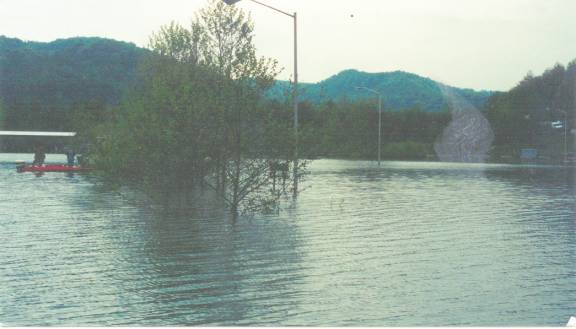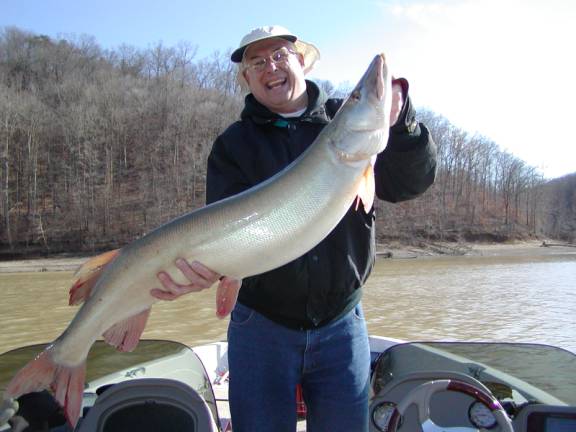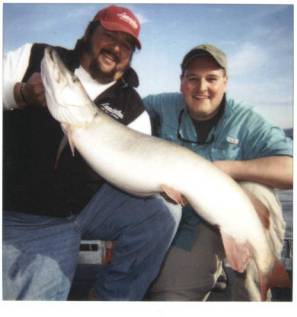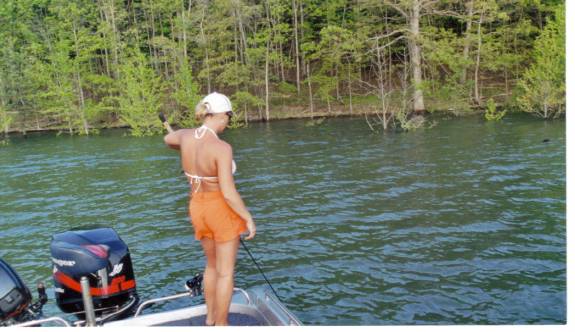| From southern reservoirs to the rivers of the mid west high water is something that much too often effects muskie fishing, especially in the spring but many times summer and fall are affected too. Over the past 15 years my clients and I have been faced with high water levels during all seasons and with a little adjustment we have still been able to be suggessful. Although similar conditions each season takes different tactics to be consistent and it takes different methods as the water rises and falls. My clients and I though our achievements as well as the observations of other anglers have added the following methods to our arsenal.
 |
On The Way Up… Overlooked River Method
A few years back while fishing the Wisconsin River at Plover with local guide and owner of T-N-T Tackle Dave Lutz we stumbled onto a very dependable pattern under very tough rising water conditions when most anglers were going fishless. The previous week we had fished a stumpy flat where we contacted fish on the slack side of the timber, upon our return the following week we found the water over a foot higher than the week before. The stumps we had fished are now just inches above the water or completely covered. With the river flooded the fish seemed to be inactive and probably still hanging very tight to cover. Floating with the current targeting the protruding stumps where we had found them on the last trip left Dave and I scratching our heads. Then we recapped the previous trip and remembered a few unwilling fish we had seen the week before just hanging near the surface but right on the structure, the key was that all the fish had seemed to be pointed up stream. That’s when Dave suggested we change our approach; we targeted that same structure only positioning the boat into the current. We realized that the biggest mistake we where making is not keeping the lure in the strike zone long enough. Most novice muskie anglers only float downstream and bring their lures upstream. When they do that, their lures are in the zone only about 1 foot per cast. I learned fast that experienced river musky hunters spent most of their time doing just the opposite especially while water levels are up. This approach keeps the lure in front of the fish longer and draws the frequent spook or reaction strike as the lure comes rapidly into view. It seems that river muskies show preference to thinner bucktails as a rule, two baits I have found great success with are the Rabid Squirrel and the T-N-T TriGlide. Stained conditions is where the TriGlide excels, its unusual double blades produces a unique flash and vibration.
End of Summer Rains
The cool heavy rains of late summer almost always results in dropping surface temps and rising conditions on my home waters of Kentucky’s Cave Run Lake that often produces some of the best fishing action of the year. I have observed similar circumstances on Illinois’ Lake Shelbyville. Under these situations the lakes coves act as magnets pulling great numbers of muskies into its cool shallowest depths. Muskie here have one thing on their minds, food. Giant schools of shad can be spotted near the flooded shorelines in depths of less than 5 feet. Anglers that repeatedly attack the areas near those newly covered banks often come away with some very big fish. Baits with multiple blades become my favorites here, Shumway Flashers and Grim Reaper Wildcat spinnerbaits have produced many trophy fish for my clients and I over the years. But not to be overlooked are GR’s Wildcat Buzzbaits, Musky Innovations Bulldawg and Realfish, over the past few years’ soft plastics has produced a great number of the bigger fish under these conditions. Whether throwing soft plastics or blades you must present your baits tight to the banks and cover the areas thoroughly as these muskies seem to be continuously on the move in search of a meal.
 |
Late Season Uprising
The late season on southern reservoirs means drawdown towards winter pool. However, occasionally that drawdown is halted by rising waters. Old timers on southern reservoirs have always used one sure fired way to locate late season muskies as its banks fill with long line surface trolling method, well not completely let me explain. For years I watched these guys consistently boat fish as the cooler water rose above the once surface matted milfoil. Yes their trolling passes drove right over our massive weed beds that just days before covered the surface. How were they trolling in only 1 to 2 feet above the weeds? What were they trolling?
The answer was spinnerbaits, however the key to there success was a long lined slow moving presentation. This took some time to be effective for me; I had to learn how slow and how far from the boat to present my lure. My rule of thumb here is to present my baits from 90 to 120 feet behind the boat depending on the distance between the surface and the weed tops to keep from spooking these already stunned fish. As for speed I like to go as slow as possible so the lure stays in sight and occasionally breaks the surface, usually between 2 and 3 miles per hour. This type presentation in the inaugural year of the PMTT at Cave Run gave my partner Don Phieffer and I our first top five finish after a day and a half of frustration. My lure choices under these conditions are a 1 or 1-1/2 ounce in both rubber and hair, my clients and I have found better production from Grim Reapers and C.J.’s. I let light penetration tell me what color to use, if the suns out I go more natural, maybe my best two have been all white and a black/red combo. Under low light conditions I tend to stay with brighter selections like black/orange and black/chartreuse. Another pointer that trial and error has discovered for me is rod selection; try a longer fast tipped rod like the Lamiglas 8′.6″. The longer rod with a limber tip keeps your line tighter and the lure from falling to far into the cover as your boat turns. However keep in mind that main factor just might be keeping your lure close enough to generate a strike so cover these areas very aggressively.
 |
On The Drop… Contact Trolling
On southern reservoirs like Shelbyville, Kincaid, Pomme De Terre, Cave Run and Green River one sure fire time to tune up your trolling skills is as those flooded waters start to quickly drop. A rapid drop in water levels seems to move the muskies to the outside edge of the cover of all types. Whether its sand flats, timber, riprap, rock walls or weeds fish here seem to act in the same way, inching away from cover in 5 to 12 feet as the water levels hastily fall. Using the short line method (7 to 15 feet behind the boat) present your lure just outside the structure at speeds between 4 to 5.5 mph, close enough to come in contact with it occasionally. These sluggish muskies generally aren’t that aggressive, so your second or third pass in the same area maybe the one that pays off. I’ve found that a smaller than normal lure selection to be most suggessful, try smaller jointed Wiley’s and Leo’s or Crane baits. Don’t be caught up in that stained water bright baits thing, they work but sometimes it takes something more natural.
 |
Finesse Baitcasting
I have had the luxury of guiding somewhere between 3 to 4 thousand muskie anglers over the past 15 years with a wide variety of styles and presentations. But the number one most common similarity would be over-casting, no not casting too much but casting too far. Too many long off-target casts, yes I believe that this over casting far more hurts than helps. So now in my Ranger we often spend some time doing what I call finesse baitcasting. What I mean here is to get our boat tighter to the structure and make short accurate cast as tight as you can get to the cover. Finesse baitcasting is the term I came up with but the patterns not. Fishing with friend, fellow guide and a very successful tournament angler Scott Salchil opened my eyes about lure presentation. Scott scores more big fish than anyone on Cave Run when a quick dreaded drawdown hits our lake. Scott concentrates on bait placement knowing where his bait is every second of the retrieve while feeling the lure every inch on its way back to the boat. I’ve tried to pass this valuable “know how” onto my clients ever since. Short precise cast, lure location and touch are the key ingredients to finesse baitcasting which can be very hard to master for the rapid paced muskie angler. This type presentation is most effective under falling water conditions. A rubber presentation seems to be the most productive by far but lure location is key during a rapid drawdown.
Creek Channels
“By creek channels I mean channels in the backs of creeks where the banks or flats are 2 to 4 feet deep and drop in a channel 8 to maybe 12 feet deep”. Normally, the edges of the channel will have a variety of cover, like laydowns, stumps or scattered weeds, and the strike zone will usually be right on the edge where the water drops into the channel. Here is where slow roll’ in spinnerbaits have always been common place with many southern anglers under rapid falling water conditions constantly touching the bottom. But now many anglers are adding a somewhat reborn presentation, jigging nothing more than a bass fishing approach. It’s no secret while fishing the PMTT that a lot of money has been won during several tough bites over the past few years to guys slowly working jigs near or on the bottom in many different depths. Not to suggest that I’m a great jig fisherman but I have boated several while jigging and most came as water levels dropped at Cave Run. Slowly moving these jigs in more of a walleye presentation in deeper water and as I stated earlier just bass fish the shallows. All three methods can produce by staying on the channel near the bottom as the water drops. Jigs like the Bait Rig’s Esox Cobra and Musky Mayhem’s new Stick’em tipped with various types of rubber seem to be steady producers when working near or at the bottom. One good tip to remember with this presentation is to watch your line and rod tip as strikes can be very light as the high water drops.
Slow Delayed Drop
As waters slowly fall muskies tend to be more territorial nature. Under prolonged drawdown conditions baitfish seem to hold in closer to shore. While pre-fishing for a PMTT Ranger Boats Championship on Lake Shelbyville in Illinois with Kevin Nash, after some frustration we finally noticed that the casts that landed closet to shore spooked more shad. After the first day we discovered that most the shad was hanging on the inside edge of the timber in creek arms, rather than the areas in the backs of these same coves where we’ve found them under normal conditions. All it took then was finding what bait they would take. Once we found that we starting boating fish, Kevin and I found long armed spinnerbaits did the trick. Repeatedly I have tried this method on different bodies of water at all times of the year and my clients and I have taken numerous muskies up 50.5 inches as the lake levels slowly dropped.
Water Clarity
Tainted visibility is often associated with waters that have climbed above their normal levels; this is generally always true during early season conditions however late season rains many times leave things pretty clear. In most of the musky range soaked spring and early summer banks up sorbs most of the sediments that stains the first few feet of water clarity other times of the year. While guiding I have always stressed the value of the figure 8 but under abnormal water levels I really put a higher level of emphasis’s on it whether stained or clear water. A larger than normal percentage of our fish are taken under these conditions at boatside, with no warning signs.
As muskie anglers most every day we’re on the water brings different challenges, high water whether falling or rising will surely become a factor in your pursuit in the ‘King of Fresh Water”, understanding the muskies habits will shorten the learning curve. When fishing these unsettled fish whether trolling or casting remember that boat control is crucial, with some practice you and your lure will stay closer to the strike zone. A variety of methods including those I’ve mentioned above can help overcome high water conditions at different times of the year, so give one a try next time the waters more than “knee deep”.
Tony Grant has been chasing muskies for nearly 20 years. As his career started on Kentucky’s Cave Run Lake he has now expanded his guiding to the waters of Wisconsin and Minnesota during the southern muskies dangerously hot summer water temps. In 2005 Tony teamed up with Gregg Thomas to form Musky Road Rules, a series of “Cabin Fever Clinics” and Schools with “On the Water Workshops” across the mid west muskie range. Visit Tony’s sites www.kymuskie.com www.muskiesupnorth.com
www.tonygrantoutdoors.com and www.muskyroadrules.com
|